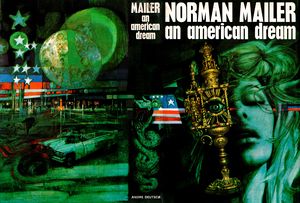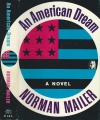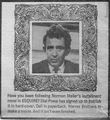An American Dream Expanded: Difference between revisions
m (Updated category.) |
mNo edit summary |
||
| Line 36: | Line 36: | ||
[[Category:Projects]] | [[Category:Projects]] | ||
Revision as of 16:01, 22 March 2019
| An American Dream | Expanded | Bibliography | Letters | Timeline | Word Count Comparison | Credits |
This project is coming in the spring of 2019. If you’d like to contribute, see the discussion page. |
| “ | An American Dream is Norman Mailer’s first novel in nine years. He wrote it at a high pitch, each chapter appearing in Esquire while he was still at work on the next: a method now unusual but common enough among the great novelists of the nineteenth century, which contributed much to the quivering tension of the story.
The theme of challenge suggested by Mailer’s choice of this method is very much a part of the book. His hero challenges the Devil himself. Stephen Rojack kills his wife, lies to the police, is interrogated by them, discovers a woman, his wife’s opposite, in whom he senses the truth and strength he longs for. The ingredients of his story are deliberately those familiar from many a thriller or movie-murder—suspense, sex—but Rojack lives these experiences with a fierce intensity which shatters their popular image and reveals extraordinary meanings behind them. He is a man who believes in God and the Devil, and to whom God is courage, not love. His actions become explosively significant because he feels that any one of them might open the crack through which the Devil’s power, or that of God, could flood in. Simply on the level of ‘what will happen next?’ An American Dream grips relentlessly: will the suspicious police pounce on Rojack? Will he and Cherry, his new girl, be able to establish the love which has begun to grow between them? But beyond this there is the immense exhilaration springing from the boldness and passion with which Norman Mailer tackles his central theme of man as the battleground for God and the Devil. This is his most exciting book since The Naked and the Dead, which became a modern classic and has sold, over two and a half million copies in the English language. |
” |
| — Dust jacket text, British edition, Andre Deutsch, April 1965. | ||
Bibliography
Reviews
- Aldridge, John W. (March 19, 1965). "The Big Comeback of Norman Mailer". Life. p. 12.
Books
- Leeds, Barry H. (1969). The Structured Vision of Norman Mailer. New York: NYU Press.
- Lennon, J. Michael, ed. (2004). Norman Mailer's Letters on An American Dream, 1963–1969. Shavertown, PA: Sligo Press.
Essays
- McKinley, Maggie (2015). "Existentialism, Violent Liberation, and Racialized Masculinities: Norman Mailer's "The White Negro" and An American Dream". Masculinity and the Paradox of Violence in American Fiction, 1950-75. London: Bloomsbury Academic.






